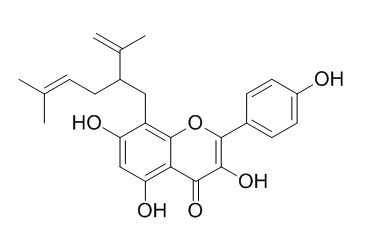8-Lavandulylkaempferol
8-Lavandulylkaempferol exhibits significant inhibitory effects with IC(50) values of 7.10 and 8.11 microM for butyrylcholinesterase and acetylcholinesterase, respectively. It shows inhibitory activities against aldose reductase, with the the IC50 of 0.79 microM.
Inquire / Order:
manager@chemfaces.com
Technical Inquiries:
service@chemfaces.com
Tel:
+86-27-84237783
Fax:
+86-27-84254680
Address:
1 Building, No. 83, CheCheng Rd., Wuhan Economic and Technological Development Zone, Wuhan, Hubei 430056, PRC
Providing storage is as stated on the product vial and the vial is kept tightly sealed, the product can be stored for up to
24 months(2-8C).
Wherever possible, you should prepare and use solutions on the same day. However, if you need to make up stock solutions in advance, we recommend that you store the solution as aliquots in tightly sealed vials at -20C. Generally, these will be useable for up to two weeks. Before use, and prior to opening the vial we recommend that you allow your product to equilibrate to room temperature for at least 1 hour.
Need more advice on solubility, usage and handling? Please email to: service@chemfaces.com
The packaging of the product may have turned upside down during transportation, resulting in the natural compounds adhering to the neck or cap of the vial. take the vial out of its packaging and gently shake to let the compounds fall to the bottom of the vial. for liquid products, centrifuge at 200-500 RPM to gather the liquid at the bottom of the vial. try to avoid loss or contamination during handling.
Appl. Sci.2021, 11(1),14.
Nutrients.2024, 16(22):3805.
Clin Exp Pharmacol Physiol.2020, doi: 10.1111
Biosci Biotechnol Biochem.2021, 85(10):2153-2160.
Plant Cell,Tissue & Organ Culture2016, 127(1):115-121
J Nat Prod.2023, 86(2):264-275.
Revista Brasileira de Farmacognosia2024, 34:1091-1100.
Aquaculture2017, 481:94-102
Biochem Pharmacol. 2023, 210:115463.
Korean J. Food Preserv.2023, 30(4):663-668.
Related and Featured Products
J Pharm Pharmacol. 2008 Sep;60(9):1227-36.
Inhibitory activities of prenylated flavonoids from Sophora flavescens against aldose reductase and generation of advanced glycation endproducts.[Pubmed:
18718128]
Important targets for the prevention and treatment of diabetic complications include aldose reductase (AR) inhibitors (ARIs) and inhibitors of advanced glycation endproduct (AGE) formation.
METHODS AND RESULTS:
Here we evaluate the inhibitory activities of prenylated flavonoids isolated from Sophora flavescens, a traditional herbal medicine, on rat lens AR (RLAR), human recombinant AR (HRAR) and AGE formation. Among the tested compounds, two prenylated chalcones--desmethylanhydroicaritin (1) and 8-Lavandulylkaempferol (2)--along with five prenylated flavanones--kurarinol (8), kurarinone (9), (2S)-2'-methoxykurarinone (10), (2S)-3beta,7,4'-trihydroxy-5-methoxy-8-(gamma,gamma-dimethylally)-flavanone (11), and kushenol E (13) were potent inhibitors of RLAR, with IC50 values of 0.95, 3.80, 2.13, 2.99, 3.77, 3.63 and 7.74 microM, respectively, compared with quercetin (IC50 7.73 microM). In the HRAR assay, most of the prenylated flavonoids tested showed marked inhibitory activity compared with quercetin (IC50 2.54 microM). In particular, all tested prenylated flavonols, such as desmethylanhydroicaritin (1, IC50 0.45 microM), 8-Lavandulylkaempferol (2, IC50 0.79 microM) and kushenol C (3, IC50 0.85 microM), as well as a prenylated chalcone, kuraridin (5, IC50 0.27 microM), and a prenylated flavanone, (2S)-7,4'-dihydroxy-5-methoxy-8-(gamma,gamma-dimethylally)-flavanone (12, IC50 0.37 microM), showed significant inhibitory activities compared with the potent AR inhibitor epalrestat (IC50 0.28 microM). Interestingly, prenylated flavonoids 1 (IC50 104.3 microg mL(-1)), 2 (IC50 132.1 microg mL(-1)), 3 (IC50 84.6 microg mL(-1)) and 11 (IC50 261.0 microg mL(-1)), which harbour a 3-hydroxyl group, also possessed good inhibitory activity toward AGE formation compared with the positive control aminoguanidine (IC50 115.7 microg mL(-1)).
CONCLUSIONS:
Thus, S. flavescens and its prenylated flavonoids inhibit the processes that underlie diabetic complications and related diseases and may therefore have therapeutic benefit.
Am J Chin Med. 2010;38(2):415-29.
Selective inhibition of prenylated flavonoids from Sophora flavescens against BACE1 and cholinesterases.[Pubmed:
20387235]
These findings have led to a further search for other possible constituents potentially contributing to the strong inhibitory activity of the S. flavescens extract.
METHODS AND RESULTS:
In this study, BACE1 activities were significantly inhibited by 8-Lavandulylkaempferol (IC(50) 7.29 microM), kuraridinol (IC(50) 7.10 microM), kuraridin (IC(50) 6.03 microM), and kushenol C (IC(50) 5.45 microM) from the ethyl acetate fraction, along with desmethylanhydroicaritin (IC(50) 1.86 microM), xanthohumol (IC(50) 7.19 microM), and leachianone G (IC(50) 8.56 microM) from the dichloromethane fraction of the extract.
CONCLUSIONS:
The results indicate that the prenyl group, rather than the lavandulyl group, and the flavonols and chalcones, rather than flavanones, might make predominant contributions to BACE1 inhibition. In particular, 8-Lavandulylkaempferol exhibited significant inhibitory effects with IC(50) values of 7.10 and 8.11 microM for butyrylcholinesterase and acetylcholinesterase, respectively, when compared to its counterpart, desmethylanhydroicaritin.
Arch Pharm Res. 2005 Dec;28(12):1333-6.
A new lavandulylated flavonoid with free radical and ONOO- scavenging activities from Sophora flavescens.[Pubmed:
16392664]
METHODS AND RESULTS:
A new lavandulylated flavonoid, 8-Lavandulylkaempferol (1), was isolated from the roots of Sophora flavescens AITON (Leguminosae). The structure of this compound was determined via spectroscopic analysis.
CONCLUSIONS:
Compound 1 was determined to be a scavenger on both 1,1-diphenyl-2-picrylhydrazyl radicals and ONOO-.



